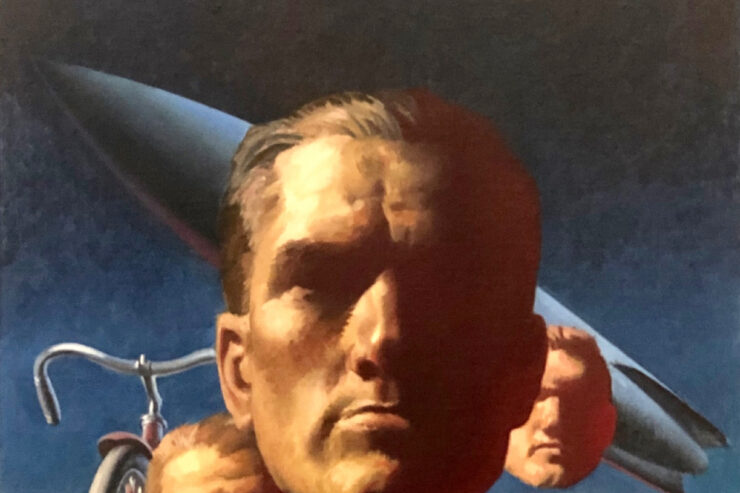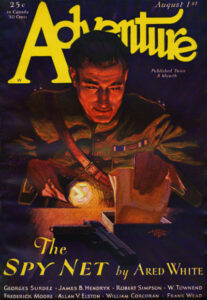 Hubert Rogers was born on December 21, 1898, in Prince Edward Island, Canada. A promising art student, Rogers emigrated to the United States following the First World War. He continued studying art in Boston and New York, working for The New York Herald Tribune and, later, The New York Times to support his studies. In 1927, he began freelancing for the pulp magazine industry, contributing covers and interior illustrations to Ace-High, Adventure, The Blue Book Magazine, Romance, True Strange Stories, and West.
Hubert Rogers was born on December 21, 1898, in Prince Edward Island, Canada. A promising art student, Rogers emigrated to the United States following the First World War. He continued studying art in Boston and New York, working for The New York Herald Tribune and, later, The New York Times to support his studies. In 1927, he began freelancing for the pulp magazine industry, contributing covers and interior illustrations to Ace-High, Adventure, The Blue Book Magazine, Romance, True Strange Stories, and West.
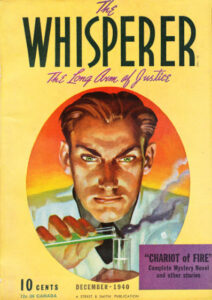 During the Great Depression, Rogers moved to the American West, working as a lecturer for the CCC. After returning to New York in 1936, he resumed working for the pulps, contributing covers and interiors to Adventure, Argosy, Dime Adventure, Dime Sports, and Short Stories before settling in with Street & Smith in 1939. Although best known for the 58 covers that he painted for Astounding Science Fiction, Rogers also contributed covers to Crimebusters, Detective Story Magazine, Love Story, Sport Story, The Whisperer, Wild West Weekly, and The Wizard/Cash Gorman. His May 1947 cover illustrating Henry Kuttner’s and C. L. Moore’s “Fury” is considered to be one of the finest cover paintings ever done for Astounding.
During the Great Depression, Rogers moved to the American West, working as a lecturer for the CCC. After returning to New York in 1936, he resumed working for the pulps, contributing covers and interiors to Adventure, Argosy, Dime Adventure, Dime Sports, and Short Stories before settling in with Street & Smith in 1939. Although best known for the 58 covers that he painted for Astounding Science Fiction, Rogers also contributed covers to Crimebusters, Detective Story Magazine, Love Story, Sport Story, The Whisperer, Wild West Weekly, and The Wizard/Cash Gorman. His May 1947 cover illustrating Henry Kuttner’s and C. L. Moore’s “Fury” is considered to be one of the finest cover paintings ever done for Astounding.
According to fan historian Alva Rogers:
It is true that today we have men and women of considerable talent writing for the field, people who write sophisticated, mature — “slick” if you will — science fiction. . . . However, the magic, that hard-to-define Sense of Wonder, the excitement that surrounded Astounding in the years of the Golden Age . . . seems to be sadly lacking these days . . . No longer is there that unbearable and interminable wait between issues; the thrill of a beautiful Rogers cover standing out like a diamond surrounded by paste as you approach the newsstand . . .
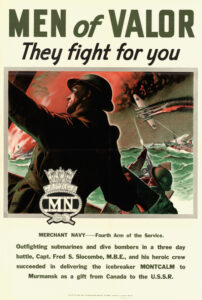 During World War II, Hubert Rogers returned to Canada to contribute to the war effort. He created a number of posters for the Wartime Information Board and other organizations in Ottawa. Following the war, he stayed busy with pulp assignments into the early 1950s. He also created dust jacket art and interior illustrations for Shasta Publishers. The last of his cover paintings was created for the April 1952 issue of Astounding Science Fiction, while the last of his interior illustrations appeared in the January 1956 number.
During World War II, Hubert Rogers returned to Canada to contribute to the war effort. He created a number of posters for the Wartime Information Board and other organizations in Ottawa. Following the war, he stayed busy with pulp assignments into the early 1950s. He also created dust jacket art and interior illustrations for Shasta Publishers. The last of his cover paintings was created for the April 1952 issue of Astounding Science Fiction, while the last of his interior illustrations appeared in the January 1956 number.
During this period Rogers also developed a growing reputation as a portrait artist, painting a number of portraits of prominent Canadian and U.S. citizens. He died in Ottawa in 1982 at age 83.
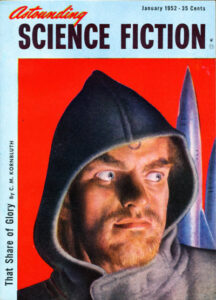 Keep watching our website for more pulp history profiles. Then plan to attend next year’s PulpFest. We’ll be highlighting the many ways that pulp fiction and pulp art have inspired writers, artists, film directors, software developers, game designers, and other creators over the decades.
Keep watching our website for more pulp history profiles. Then plan to attend next year’s PulpFest. We’ll be highlighting the many ways that pulp fiction and pulp art have inspired writers, artists, film directors, software developers, game designers, and other creators over the decades.
PulpFest 2024 will take place August 1 – 4 at the DoubleTree by Hilton Hotel Pittsburgh – Cranberry in Mars, Pennsylvania. Click here to learn how you can register for summertime’s great pulp con.
Our featured image is excerpted from Hubert Rogers’ original cover artwork for the June 1951 Astounding Science Fiction, illustrating Eric Frank Russell’s novella, “. . . And Then There Were None.”
Our lead image is the August 1, 1930 number of Adventure, with a cover by Hubert Rogers. The cover story is Ared White’s “The Spy Net.” We’ll be saluting espionage fiction in the pulps at PulpFest 2024, in celebration of the 90th anniversary of Operator #5 and Secret Agent X.
In 1939, Hubert Rogers began contributing cover and interior art to Street & Smith. Although best known for the 58 covers that he contributed to John W. Campbell’s Astounding, the artist also painted covers for other Street & Smith magazines, including The Whisperer. Featured above is Rogers’ cover for the December 1940 issue of the Street & Smith hero pulp.
For more on The Whisperer, please visit the PulpFest YouTube Channel at https://www.youtube.com/@pulpfest for Craig McDonald’s take on the character at https://youtu.be/tHISFUE9VMY. It’s part of Craig’s popular film series exploring “The Great Pulp Heroes.”
In 1942, Hubert Rogers returned to his native Canada to help with the war effort. Pictured above is one of the posters that he designed for the Wartime Information Board in Ottawa.
 Following World War II, Hubert Rogers resumed his association with Street & Smith’s Astounding Science Fiction. Above is one of his final covers for the magazine — the January 1952 number — illustrating the C. M. Kornbluth novella, “That Share of Glory.” Although he would continue to contribute interior illustrations to the magazine until early 1956, Rogers would paint just two more covers for the Street & Smith digest.
Following World War II, Hubert Rogers resumed his association with Street & Smith’s Astounding Science Fiction. Above is one of his final covers for the magazine — the January 1952 number — illustrating the C. M. Kornbluth novella, “That Share of Glory.” Although he would continue to contribute interior illustrations to the magazine until early 1956, Rogers would paint just two more covers for the Street & Smith digest.
In 1935, Adventure magazine celebrated its 25th anniversary by publishing a special “All-Star Edition” for its November issue. Hubert Rogers was appropriately selected to contribute the magazine’s covert art.
Leslie Silberberg is a writer and popular culture enthusiast who began posting on our website in 2022. She enjoys the science fiction pulps, particularly the work of such leading female writers as Leigh Brackett, Claire Winger Harris, Zenna Henderson, Judith Merril, C. L. Moore, Margaret St. Clair, Wilmar H. Shiras, Francis Stevens, and Leslie F. Stone.
To learn more about pulp heroes and PulpFest visit our YouTube Channel . . .

